The Sacra di San Michele, also known as Saint Michael’s Abbey, stands majestically on the mountainside. Its impressive architecture makes you wonder how it was built in the Middle Ages. Surrounded by legends of angels, the Abbey has a mystical charm that has attracted visitors and pilgrims for centuries.
Table of Contents
What to See at the Sacra di San Michele
The Sacra di San Michele is an iconic landmark in the Piedmont region. This self-sufficient complex is steeped in centuries of history. Over the years, it has served various purposes: as a refuge for monks and pilgrims, a defensive stronghold, a school of theology, and, most importantly, a place of worship. It also inspired Umberto Eco’s renowned historical novel The Name of the Rose.
PLAN YOUR TRIP TO ITALY
Stay connected on the go with a Holafly eSIM, offering unlimited data at reliable 3G, 4G, and LTE speeds across Italy.
For added peace of mind during your travels, take out Heymondo travel insurance, perfect for a stress-free and well-protected adventure.
If you plan to explore beyond the main cities, renting a car is the best way to discover Italy’s hidden gems at your own pace.
The Monks’ Sepulchre: Secrets Beneath the Stone
The first structure you encounter on the path to the Sacra di San Michele is the small ruin known as the Monks’ Sepulchre. Its name comes from the belief that it was once a chapel where resident monks were buried.
Recent studies, however, suggest that it might actually be an early replica of the Holy Sepulchre in Jerusalem. In other words, it served as a medieval precursor to the popular Sacri Monti pilgrimage trend, like the Sacro Monte of Varallo. These replicas provided spiritual journeys on a budget long before this concept became widely recognised.
Saint Michael the Warrior by Paul dë Doss-Moroder
As you enter the Abbey, a modern statue of Saint Michael, depicted as a warrior angel, greets you. Positioned on a rocky outcrop by a helicopter, the statue reminds visitors of the Abbey’s original role as a physical and spiritual stronghold.
Paul dë Doss-Moroder’s interpretation of the Archangel Michael differs from traditional images. Instead of a fierce commander of heavenly armies, this Saint Michael appears feminine and serene. He seems at peace, even after defeating the forces of hell and clipping Lucifer’s wings.
This unconventional representation holds a deeper message of vigilance and compassion. Though the battle is won, the angel has one hand open and facing downward. He is ready to take up his sword again if evil returns. His other hand is open and facing upwards, symbolising welcome and protection.
The Stairway of the Dead: A Haunting Path
The most striking feature of Saint Michael’s Abbey, both in name and history, is the Stairway of the Dead. To enter the church, you must climb 243 steps built directly into the rock face.
At the base of the stairs, the entrance capitals are adorned with lions facing opposite directions, symbolising the past and the future. They clearly reference Ancient Egyptian art because, contrary to popular belief, the Middle Ages were a time of cultural exchange and influence.
Since its construction, the Stairway of the Dead has been a burial site, and several sarcophagi are still visible today. The name comes from the skeletons of monks that once hung along the staircase. According to the Sacra di San Michele’s official website, these skeletons remained in place until 1936. However, some local sources claim they were still displayed until the 1960s.
The idea of displaying corpses as decoration is unsettling by today’s standards. However, they were a memento mori, a stark yet spiritual reminder that death is a part of life. Understanding this, the Stairway of the Dead takes on a deeper meaning and becomes a symbolic journey from earthly life to heaven.
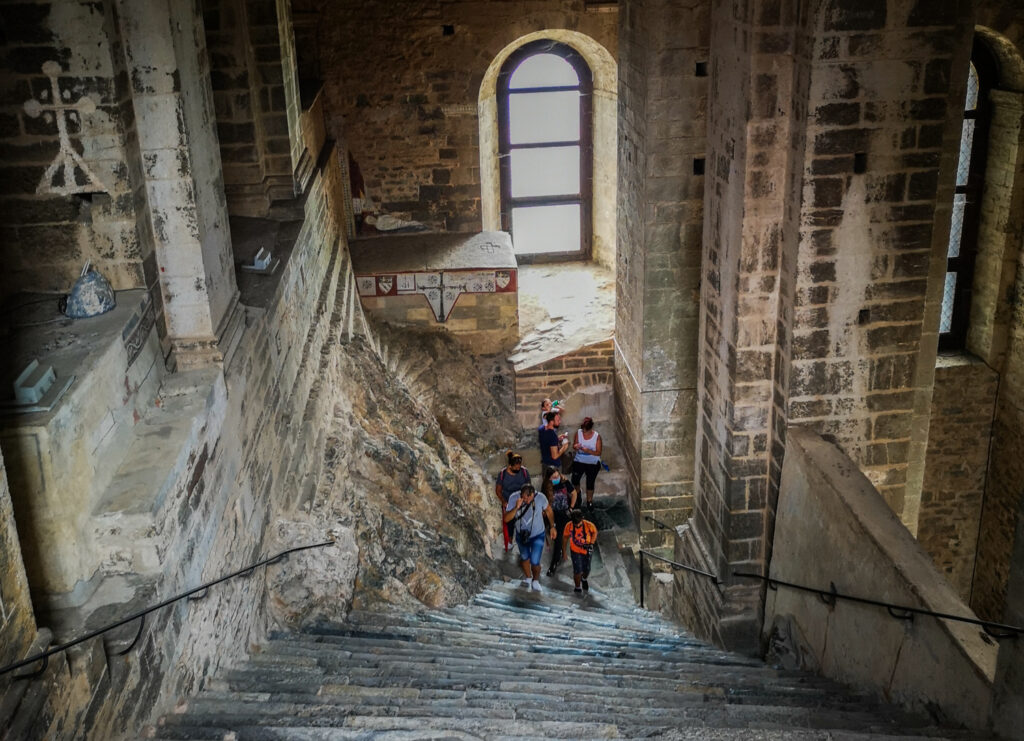
The Zodiac Portal: Symbols in Stone
At the top of the Stairway of the Dead, the Zodiac Portal showcases a unique blend of mystery and symbolism. Interestingly, the portal was originally intended to be viewed from inside the Abbey instead of serving as an entrance gate.
Its name derives from the twelve zodiac signs and the constellations carved around its arch. During the Middle Ages, the zodiac was a controversial topic within the Catholic Church. It likely symbolises cosmogonic eras, but the exact meaning remains unclear.
Upon closer inspection of the Zodiac Portal, you will also see fierce beasts interwoven with delicate flowers and several gryphons, mythical creatures that combine features of a lion and an eagle, very popular in medieval iconography.
You’ll notice that each of the seven capitals of the Zodiac Portal displays distinct styles, materials, and themes. The number seven is intentionally symbolic, representing the seven celestial spheres.
However, these capitals were likely a mix of different commissions, many of which were reused from earlier works, as was common practice. For this reason, it’s important not to force a mystical interpretation.
The leading sculptor was Nicolao, and it is noteworthy because, during the Middle Ages, art wasn’t regarded as a form of personal expression. Artists were just skilled workers and rarely signed their works. However, Nicolao consciously signed his works with poems and inscriptions.
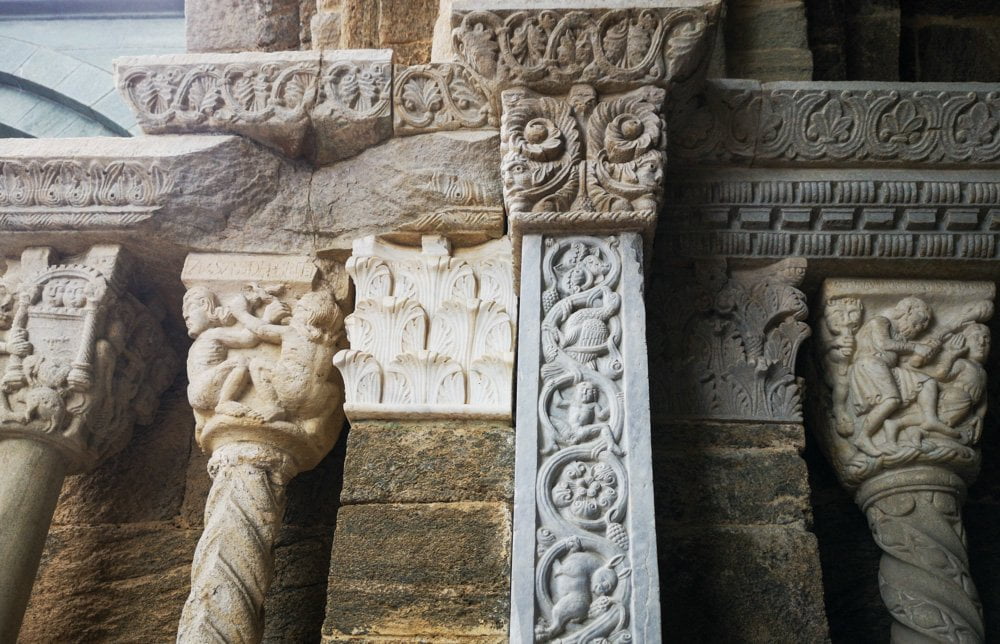
Inside the Sacred Heart: The Abbey’s Church
The church is the heart of the Sacra di San Michele. Its floor plan, uniquely skewed from the usual east-west alignment, allows it to capture sunrise light during morning mass. The architecture also amplifies music and chant within its walls.
Before entering, you can see a horizontal plaque at the entrance with an inscription that faces sideways, making it hard to read. This was a clever medieval trick: if the stones weren’t placed correctly, the writing didn’t count! More likely, it provided a practical excuse to avoid carrying another heavy stone up the mountain.
Even though you can only enter through one door, as you must follow the designated path for visitors, the church has multiple entrances, each meant for different groups, such as monks and worshippers.
Inside, you’ll find several sarcophagi holding the remains of princes from the House of Savoy. When Charles Albert of Sardinia entrusted the Abbey to the Rosminian Fathers, he also brought the bodies of his deceased relatives. This act was a sign of respect and trust. While it may sound macabre today, housing corpses in abbeys was considered an honour back then.
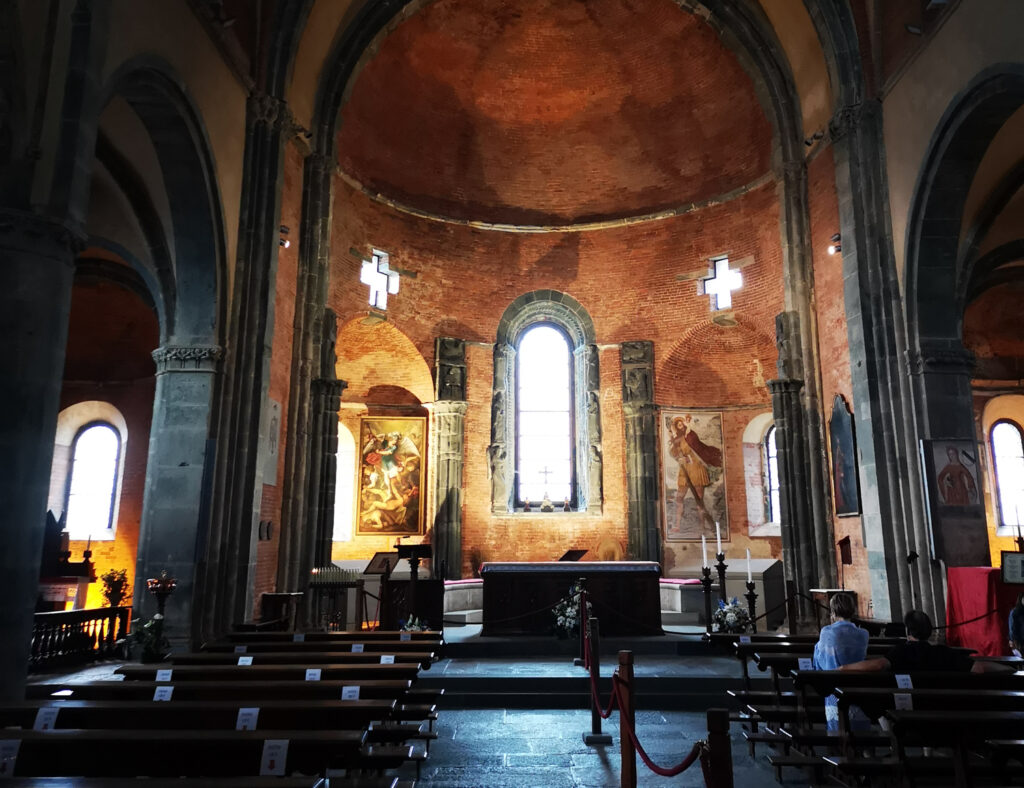
The Bell’Alda Tower: Legend on the Edge
As you step out of the church, you’ll encounter a series of ruins, including an ancient icehouse that dates back to the Abbey’s peak monastic period. The most striking ruin is the Bell’Alda Tower, a sheer cliffside structure perched precariously on the edge of Mount Pirchiriano.
This tower is famous for its stunning panoramic views and the legend of the young woman it is named after. The beautiful Alda, chased by a group of soldiers, rather than lose her honour, preferred to throw herself from the tower and was saved by Saint Michael himself.
Engineering Marvel: The Construction of the Sacra di San Michele on a Cliff Edge
At first glance, the Sacra di San Michele appears to rise directly from the rock. However, it’s actually a complex of nearly overlapping buildings. The earliest structures were small chapels used by Christian soldiers stationed at the Roman fort that once stood here.
The Vision of Hugon de Montboissier
The abbey we see today was commissioned by Hugon de Montboissier, a French nobleman. He wanted to atone for his sins and sought indulgence by constructing this abbey for the Benedictine monks. After a pilgrimage to Rome, Hugon chose Mount Pirchiriano because of the small chapels already dedicated to Saint Michael.
The Challenge of Construction
Building such an imposing abbey at this location was no small task. The Sacra di San Michele construction took nearly three hundred years to complete.
Throughout this period, architectural styles evolved, but no one dared to suggest changes at an altitude of 960 meters above sea level. The locals chose to preserve the Abbey’s Romanesque structure, adding Gothic decorations.
The only significant alteration came with the addition of flying buttresses. In 1937, architect Alfredo D’Andrade built these to prevent collapse on the church’s south side. The flying buttresses blend seamlessly with the structure, making it hard to believe they were a modern addition.
Decline and Current Status
After thriving in the Middle Ages, the Sacra di San Michele began to decline around the 14th century. The management by commendatory abbots, who were administrators rather than religious figures, led to a gradual decline in the number of resident monks. Today, only three old monks live at the abbey, supported by local volunteers.
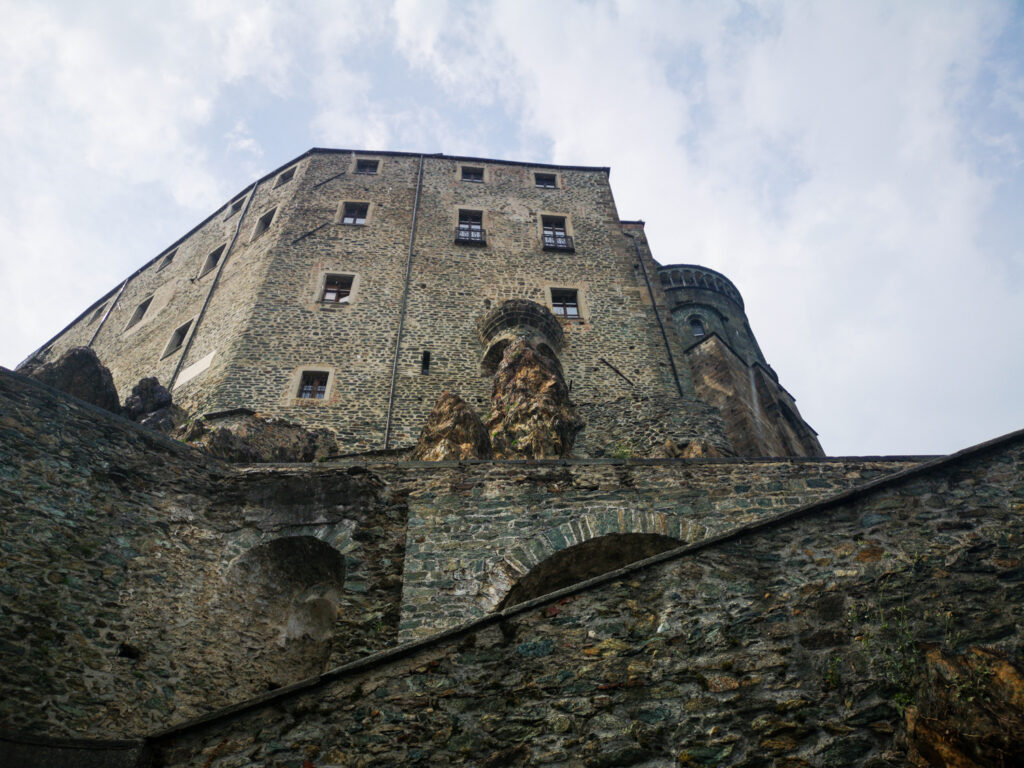
Fascinating Facts and Legends of Saint Michael’s Abbey
The legends of the Sacra di San Michele are as extraordinary as its history. This Abbey is rich in myths, stories, and fascinating curiosities that enhance its mysterious charm.
One popular legend involves the alignment of various sanctuaries dedicated to Saint Michael across Europe, including the Sacra di San Michele. It is believed these sites create a sacred geometric pattern linked by invisible spiritual energy.
Another captivating element is the geomagnetism of Mount Pirchiriano. Both locals and visitors report feeling a strange, almost mystical energy on the mountain. Many believe this energy enhances spiritual experiences, making the abbey a potent pilgrimage site.
The story of Bell’Alda adds a romantic yet tragic layer to the Abbey’s history, while numerous accounts of divine interventions bolster the Sacra di San Michele’s reputation as a supernatural place. Whether or not you believe the legends, they certainly add a touch of magic to this remarkable monument!
Saint Giovanni Vincenzo and the Prankster Angels
A curious legend about angels and Saint Giovanni Vincenzo explains why the Sacra di San Michele was built on Mount Pirchiriano. Around the year 1000, the Archbishop of Ravenna became a hermit on Mount Caprasio, which faces Mount Pirchiriano.
One night, Saint Giovanni Vincenzo dreamed of an angel who told him to build a church from nothing. Eager to obey, the hermit began gathering materials for the church on Mount Caprasio. However, each morning, planks, bricks, and scaffolding had mysteriously vanished.
According to the legend, it took him some time to realise that he could not expect to sleep soundly while his supplies kept disappearing overnight. Eventually, determined to find out what was happening, he witnessed angels flying to Mount Pirchiriano, carrying away all his materials.
Recognising this as a divine sign, he abandoned his plans for Mount Caprasio and built a church on Mount Pirchiriano instead. After this decision, the materials ceased to vanish.
Today, Saint Giovanni Vincenzo is also the patron saint of Sant’Ambrogio di Torino, a town located in the Susa Valley, beneath the Sacra di San Michele.
The Bell’Alda Leap: A Tale of Foolishness and Tragedy
The legend of the Bell’Alda tells of a young local girl named Alda and holds the memory of a leap between faith and vanity.
While fleeing from enemy soldiers, she ran into a tower above a steep cliff. With no other way to escape and protect her honour, she threw herself into the void, praying to Saint Michael.
Miraculously, the archangel heard her plea, caught her mid-air, and gently placed her unharmed at the bottom of the cliff. But when Alda returned to the village, no one believed her story.
Hurt by their doubt and driven by pride, she tried to jump again, but this time, Saint Michael didn’t intervene. Alda crashed into the valley below and died.
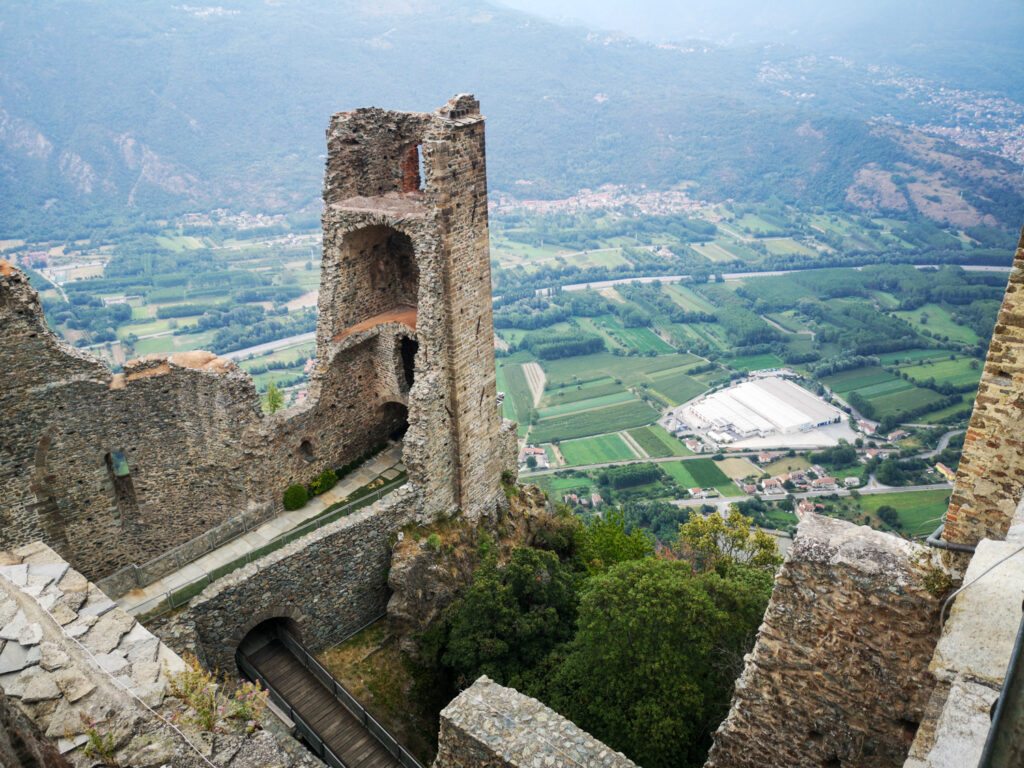
The Sword’s Path: San Michael’s Mysterious Line
Another fascinating legend is the Via Angelica, also known as the Via Michelita or Saint Michael’s Line. This pilgrimage route connects sacred sites dedicated to Saint Michael, stretching from Ireland to Israel.
Remarkably, they form an almost straight line if you map these locations. This is a stunning achievement, given the imprecision of medieval cartography.
The holy places along the Saint Michael’s Line, running from northwest to southeast, include:
- Skellig Michael Island, Ireland
- St Michael’s Mount, United Kingdom
- Mont Saint Michel, France
- Sacra di San Michele, Piedmont, Italy
- Sanctuary of Saint Michael the Archangel, Apulia, Italy
- Monastery of Saint Michael the Archangel in Panormitis, Greece
- Stella Maris Monastery on Mount Carmel, Israel
According to legend, Saint Michael himself drew this straight line with his sword during his battle against Lucifer and evil forces.
If the story of the Via Angelica intrigues you, you can actually walk the Saint Michael Pilgrimage. While I can’t confirm if the path matches the exact line of Saint Michael, it certainly leads to inspiring sacred sites.
During my visit to the Sacra di San Michele, I learned about a network of monasteries, chapels, and holy places dedicated to the saint. These sites are about thirty kilometres apart, roughly a day’s walk.
However, all Saint Michael’s sanctuaries are on rocky outcrops, inside caves, or atop mountains, offering breathtaking views. It’s a pilgrimage route full of spiritual and scenic wonder.

The Angelic Consecration: A Divine Blessing
According to legend, angels from heaven consecrated the Sacra di San Michele instead of a regular bishop. When the bishop arrived from Susa with his entourage to bless the Abbey, he found that the consecration had already been completed.
This tale serves a clear purpose: if the Abbey was consecrated through divine intervention, it would not be subject to the local diocese. Instead, it would only answer the Pope.
Almost certainly, the monks likely created this story to assert their independence from the bishop’s authority. It was an ingenious medieval strategy wrapped in mystery and faith.
The Mystery of the Spinning Compasses on Monte Pirchiriano
On the highest terrace outside the church, a strong electromagnetic field interferes with compass readings, creates static electricity, and makes your hair stand on end.
Experiencing this phenomenon in person is unbelievable. I couldn’t help but imagine how people centuries ago felt standing before such a monumental structure and witnessing this strange occurrence. Despite being very rational, I felt a deep connection to the forces of nature.
If you search online, you’ll find numerous fascinating theories about energy lines and magical geomagnetism at the summit of Mount Pirchiriano. However, there is, of course, a scientific explanation.
The rocks beneath the Abbey are rich in iron, which disrupts east-west compass readings and creates a strong electromagnetic field. Yet, this only adds to the allure of this incredible site.
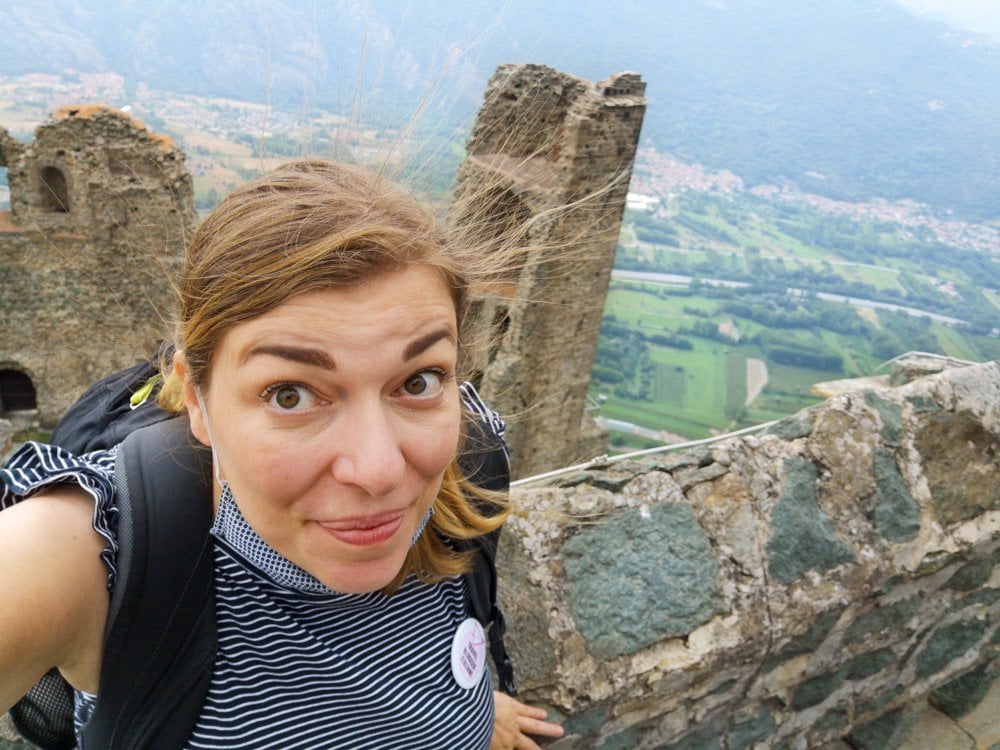
Unicorns and Saints: The Curious Art of the Sacra di San Michele
As you enter the church of Saint Michael’s Abbey, unusual animals catch your eye: unicorns and cheetahs. These creatures seem more at home in a child’s storybook than traditional Catholic art.
The first explanation is that medieval bestiaries were quite popular during the time when the Sacra di San Michele was decorated. Additionally, in remote areas like the Piedmont mountains, artistic styles during the Middle Ages often diverged from classical canons. Painters in these regions frequently improvised based on their personal style.
For example, the paintings in the Saint Michael’s Abbey often feature a curious flat, Gothic style where multiple moments unfold simultaneously, with a “unique” perspective.
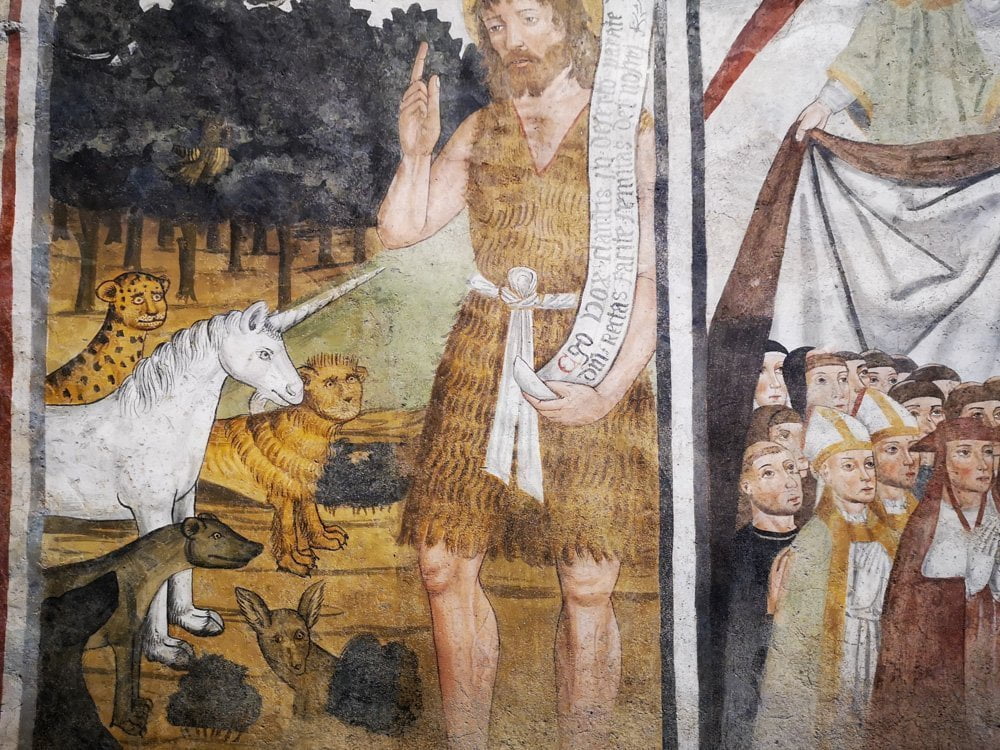
The Paintings
Most of the paintings in the Sacra di San Michele are more recent than the abbey itself. They were primarily created by Secondo del Bosco da Poirino, a local master who remains underappreciated today.
His works often depict popular scenes featuring the faces of local villagers. In the painting of Madonna della Pera, Mary is shown feeding fruit to Jesus, highlighting her nurturing motherly instincts.
In another piece, she attempts to please everyone by blending two different styles of perspective, an unusual artistic choice.
A different fresco illustrates the founding legend of the Sacra, where Saint Giovanni Vincenzo is joined by a leopard and a unicorn, creatures from medieval bestiaries that are rich with symbolism and showcase the artists’ creativity.
The Polyptych by Defendente Ferrari
Another significant work at Saint Michael’s Abbey is the Polyptych by Defendente Ferrari, showcasing the Piedmontese Mannerist style. This piece demonstrates Ferrari’s skill in merging classic themes, the Madonna and Child and the Assumption, into one composition. Saint Michael is here depicted in full battle gear, adding to the richness of the artwork.
Erased Patrons
Intriguingly, many paintings reveal erased faces of patrons, a punishment known as damnatio memoriae after shifts in power. In the fresco of the Assumption, the patron’s face has been removed. Despite this, the painting is notable for depicting the dead Madonna, a rare theme in art history.
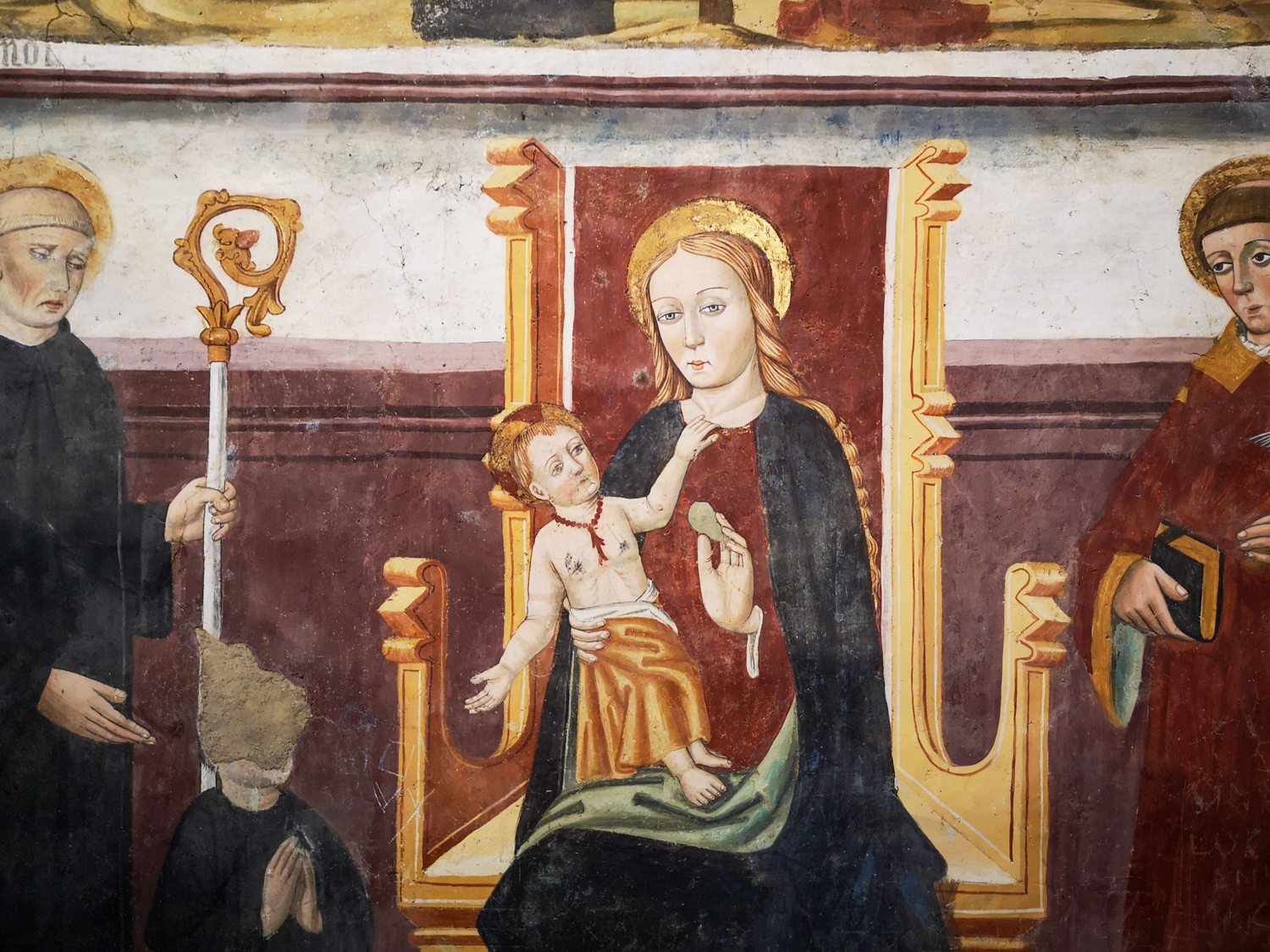
How to Plan Your Visit to the Sacra di San Michele
Having lived in the Susa Valley for several years, I have visited the Sacra di San Michele many times and often bring friends from other cities with me. Because of this experience, I have some useful tips for organizing your visit.
Guided Tours: Discover Hidden Stories
First and foremost, I recommend hiring a guide to help you fully appreciate the wonders of Saint Michael’s Abbey, especially if it’s your first time visiting.
The Sacra di San Michele is impressive due to its size and presence, but there is so much more to discover, from upside-down carvings to unique perspectives in local art.
If you’re in Turin or traveling by train, the best option is to join a half-day guided tour. Be sure to check the schedule in advance, as tours may not be available during the winter months.
Alternatively, you can book a guided tour at the ticket counter if you’re already in Valsusa and are driving to the Abbey on your own.
Private guided tours that include other attractions nearby can be convenient, especially if you have only a few days in Turin. However, be cautious about booking through portals, as many can be scams. They tend to be expensive and often only cover transportation without providing guided tours or tickets. Always check what’s included before you make a booking.
Getting There by Car and Bus
You can visit the Sacra di San Michele on your own. If you drive, there’s a paved road starting in Avigliana. Keep in mind that nearby parking is limited and quite expensive. Also, during certain times of the year, the road to the Sacra becomes one-way. Watch for signs and directions.
If you prefer to take the bus, there are options available. You can take a direct bus from Turin or reach Avigliana by train. From there, a local bus will take you to Saint Michael’s Abbey. However, local buses to the Sacra di San Michele do not run daily. It’s wise to check the bus timetable before you go, as they can change.
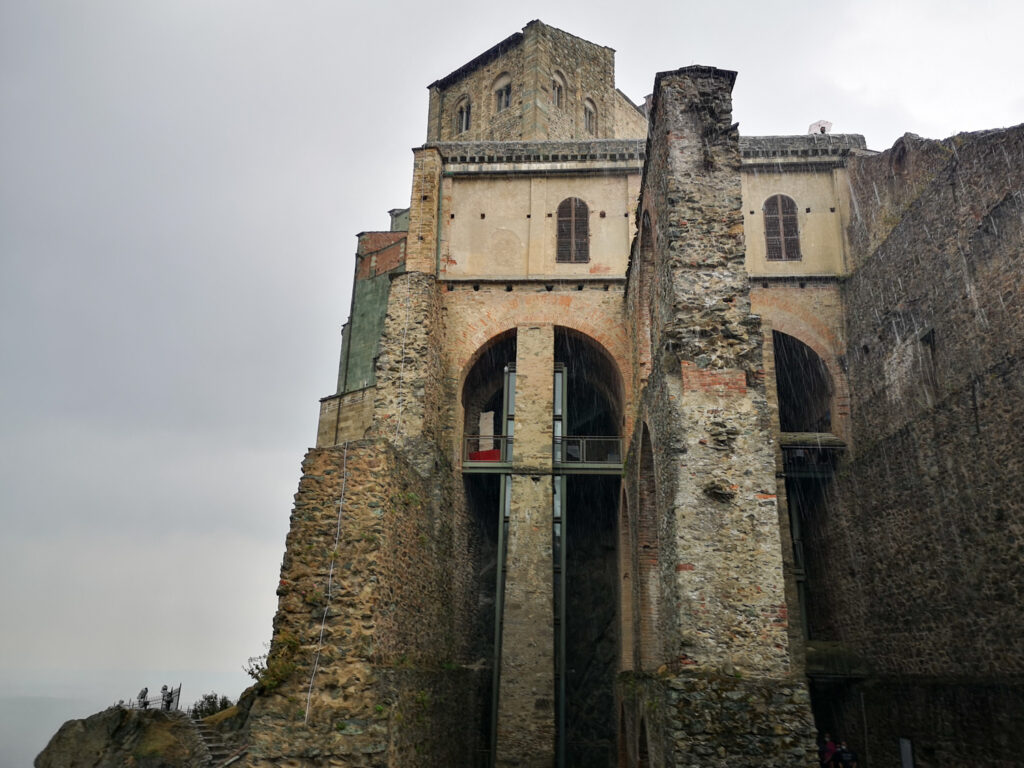
Hiking Trails and Pilgrimage Routes
If you enjoy trekking and nature, start your journey at the Sacra di San Michele. It serves as the beginning of the Sentiero dei Franchi, a hiking trail leading to the Upper Susa Valley (Valsusa).
The most renowned trail associated with the Sacra is the Via Francigena. This medieval pilgrimage route features an alpine variant that runs through the Susa Valley.
When exploring the Via Francigena, look for the variante. If you don’t, you may end up on a different path that doesn’t lead to the Sacra di San Michele.
In summer, the best way to reach Saint Michael’s Abbey is by following the trails of medieval pilgrims. From the church in Sant’Ambrogio di Torino, a charming mule track leads the way. You can also start from the nearby village of Chiusa San Michele. In either case, you’ll gain about 600 meters in elevation.
If you want a simpler, more scenic walk, you can take a path from Mortera hamlet in Avigliana. For those seeking adventure, there’s the Carlo Giorda via ferrata. It starts in Sant’Ambrogio di Torino and leads up Mount Pirchiriano.
Sacra di San Michele
Via alla Sacra, 14, 10057 S. Ambrogio di Torino (TO)

Let me know if you found these tips for visiting the Sacra di San Michele helpful. Feel free to share your experiences in the comments if you have visited Saint Micheal’s Abbey or if this blog post has just sparked your curiosity.

6 comments
I visited the Sacra di San Michele a few years ago, in the company of my aunt and my grandmother as well as my parents. It is a powerful place, austere but of undoubted charm. The stratification and its position are splendid: it really seems like a guardian among the mountains!
It’s really amazing, I totally agree with you
We visited the Sacra di San Michele a few years ago, certainly before Covid, and it was an unforgettable experience. After a steep staircase that seemed never-ending, once we reached the church, the emotions became even more intense, a genuine sense of joy mixed with a sort of vertigo. I have never felt anything like it again. The organization within the complex was excellent, with many people ready to help or even just to tell all the legends that surround that magical place.
It’s really magical, isn’t it?
I’ve been to the Sacra di San Michele several times, since I live in Piemonte and starting from elementary schools to high school, we would always get there – almost every single year – for our school trips. My last visit dates back to three or four years ago, and this is the trip that I remember more vividly. It’s a magical place, also if you think about the other abbeys along the Lines di San Michele. I’ve visited the ones in Ireland, the UK and France and all the power to take your breath away!
Wow, that’s interesting! I’d like to visit the other St Michael sanctuaries too. I was looking for a pilgrimage route, but apparently it doesn’t exist anymore. You can just visit each individual sanctuary because they are no longer connected.